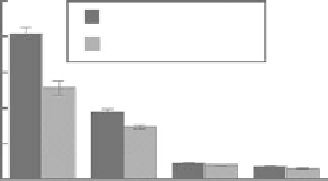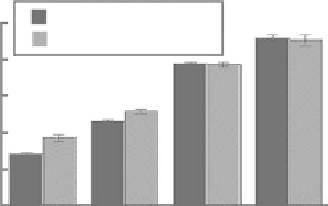Biomedical Engineering Reference
In-Depth Information
(a)
100
SHG
Merged (SHG +TPF)
80
60
40
20
0
5.5
6.5
Polymerization pH
7.5
8.5
(b)
SHG
Merged (SHG +TPF)
25
20
15
10
5
0
5.5
6.5
Polymerization pH
7.5
8.5
FIgurE 11.6
(a) Mean pore size, determined from particle analysis from SHG and combined SHG + TPF images,
of acellular collagen gels polymerized at pH 5.5, 6.5, 7.5, and 8.5. (b) Mean pore number density, determined from
particle analysis from SHG and combined SHG + TPF images, of acellular collagen gels polymerized at pH 5.5,
6.5, 7.5, and 8.5. The error bars represent standard deviation. (Reprinted from
Biophys J.
, 94, Raub, C. B. et al.,
Image correlation spectroscopy of multiphoton images correlates with collagen mechanical properties, 2361-2373,
Copyright 2008, with permission from Elsevier.)
the polymerization temperature of 4 mg/mL collagen hydrogels systematically changed the fiber vol-
ume fraction and space-filling characteristics as well as bulk shear moduli, measured by rheology.
he shear moduli
G
′ and
G
″ were found to correlate positively with SHG image fraction for these gels
(Figure 11.7a), although the correlation between the shear moduli and SHG image fraction is most linear
for the 14-37°C polymerization conditions. In this case, the collagen fibers polymerized at 4°C formed
an extremely weak, sparse gel, with most fibers not entangled and therefore not contributing to an elas-
tic stress response. In contrast, the shear moduli correlate negatively with mean-segmented SHG signal
for 4 mg/mL collagen gels with polymerization temperature-controlled microstructure (Figure 11.7b).
Since all gels contained collagen at 4 mg/mL, gels with larger diameter fibers contained fewer (though
larger with brighter SHG signal) fibers and larger pores, linking the shear moduli, SHG signal, and SHG
image area fraction. This study was an initial attempt to correlate the mechanical properties with SHG
image parameters, in an attempt to understand the origins of the shear moduli values. It was concluded
that the network space-filling characteristics, specifically of the pores between collagen fibers, play an
important role in determining the mechanical properties, and that SHG image area fraction is one way
to describe collagen network space-filling characteristics.
The second study was designed to attempt to explain bulk gel mechanics with a microstructural
model and SHG image-derived microstructural parameters. Acid-soluble collagen hydrogels consist
of an uncross-linked, tightly entangled network of semiflexible (but rather rod-like) polymer chains
(i.e., fibers), and as such, their viscoelastic properties may be modeled, employing only a handful of
microstructural input parameters [93]. Specifically, the storage modulus
G
′ scales as
G ~
′
ρ
7 /
L
p
1/5
−
(11.6)


